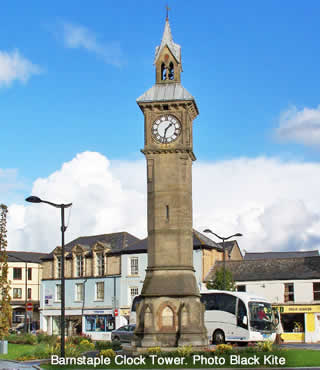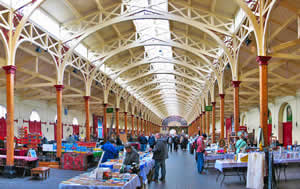Barnstaple |
|
 |
|||
North Devon's historic shopping hub |
|||||||
|
|||||||
Ever since Saxon times, Barnstaple has been North Devon's biggest commercial settlement. Its alleys and courtyards now lead to familiar businesses and modern shopping centres, but the past has far from disappeared. The Pannier Market, an undercover thoroughfare with walls of brick and a roof of glass and timber, has barely changed since its construction 150 years ago. The products on offer depend on the day of the week; sometimes it's food, sometimes it's antiques or crafts. |
|||||||
 Barnstaple Pannier Market. Photo Smalljim |
|||||||
Next door is the Butcher's Row, a line of open-fronted shops with stone columns and arched windows. Only two of them are still occupied by butchers; the others are home to fishmongers, greengrocers, delicatessens, and bakers. |
|||||||
The town's heart is its square, on the northern bank of the River Taw. It's watched over by the Albert Clock Tower, Barnstaple's biggest landmark. The locals have given it the nickname, "the four-faced liar", because its four different clocks each tell slightly different times. They seem to enjoy the look of confusion it causes on tourists' faces. |
|||||||
The waterfront is also home to the Barnstaple Heritage Centre. The exhibitions in this Grade I listed building cover the town's history since medieval times, when it was trading with America and growing rich. There's the 16th century highs, when Barnstaple sent out ships to help Francis Drake defeat the Spanish Armada, and the 17th century lows, when the Civil War ripped the community apart. If you look closely, you can still find bullets holes in some of the older buildings. The Heritage Centre takes a very interactive approach; visitors can visit recreations of Saxon England, a medieval marketplace and an 18th century opera house. |
|||||||
There's another set of exhibits at the nearby Museum of North Devon, though it has space to take a wider look at the county. They have examples of Devon's finest craft, from furniture to pottery. You can walk through a model Wellington bomber and discover how the Second World War affected life in this corner of Britain. Another gallery uses the story of Tarka the otter, a character from a 70s children's book who lived near the River Taw, to look at ecology and wildlife. |
|||||||
The same otter lends his name to the Tarka Trail, a series of foot and cycle paths that loosely follow the journey of the character in the book. It's 31 miles long, but its figure-8 shape means you can easily attempt smaller sections. If you want to travel by bicycle, there are plenty of companies that would be delighted to loan you one. |
|||||||
Besides Tarka, another important part of Barnstaple's history is its September fair, which has been going for much, much longer than anyone can remember. Its opening ceremonies still follow all the old, weird traditions, like the formal presentation of a giant, stuffed glove representing friendship. For the following four days the townsfolk, plus visitors from across the south-west, flood the assorted rides, stalls and amusements. |
|||||||
The fair gets credit for introducing theatre to Barnstaple, from as early as the 15th century. The town has had a series of theatre buildings, of which the latest is called Queen's. Since its full refurbishment in 1993 it has had a full programme of music, comedy - and pantomime at Christmas. |
|||||||
|
|||||||
Barnstaple Tourist Information Centre, The Square, Barnstaple, Devon, EX32 8LN. Tel: 01271 375 000 |
|||||||
|
Pocket Britain is optimised for use on a smartphone or tablet with internet access. All content is subject to copyright. All reasonable methods have been used to ensure information supplied is accurate at the time of publication. However, it is advisable to check information before relying on it. Privacy Policy |